Physical Address
304 North Cardinal St.
Dorchester Center, MA 02124
Physical Address
304 North Cardinal St.
Dorchester Center, MA 02124
Suddenly, VR becomes fascinating. The Meta Quest 3 offers a superb independent virtual reality experience for $500, while Apple has made a bold move with the Vision Pro, a $3,500 attempt to merge VR and augmented reality (AR). After a period of little progress, it’s worth thinking about getting an immersive headset. If you’re a VR enthusiast, it’s definitely time to upgrade from the original Quest. However, for Apple devotees or those who can afford it, the Vision Pro offers a peek into the future of the entire category. We’ve put all the major players in the VR market to the test and reviewed them; this buyer’s guide will assist you in determining which headset is the best fit for you.
VR is evolving, and it’s not just because of Apple. The terms “VR” and “AR” are merging into mixed reality, thanks to a new wave of VR headsets that use passthrough cameras to blend the virtual and real worlds. The most affordable mixed reality headset currently available is the Meta Quest 3. Priced at $500, it’s $250 more expensive than the Quest 2, but $3,000 cheaper than the Apple Vision Pro.
The Quest 3 features a newer, faster Snapdragon XR2 Gen 2 processor, which offers better graphics and a higher-resolution display than the Quest 2. It also has improved lenses, redesigned controllers, and can blend the virtual and real world with passthrough color cameras. However, Apple’s headset surpasses it in terms of display and camera quality. The Quest platform has many additional benefits: it supports hundreds of games and creative/productivity apps, offers several excellent fitness programs for effective cardio workouts, can connect to PCs, and can even serve as a work device with a bit of patience. It also has hand tracking that works without controllers, but controllers are included to provide two input options. The Quest 3 can even play “spatial” 3D videos shot on the iPhone 15 Pro.
The Apple Vision Pro is an impressive piece of technology and a cutting-edge high-end mixed reality headset that also runs iOS and thousands of iPad apps. It works without controllers using eye and hand tracking and can run multiple apps simultaneously, in addition to serving as a virtual MacBook monitor. The 4K micro-OLED displays are stunning, and videos and photos look fantastic. Apple’s device requires a tethered battery pack, is designed to work only within Apple’s ecosystem, and doesn’t have many unique apps yet at launch that do more than act as floating 2D screens. The Vision Pro could very well mark the beginning of a new era in headsets, and may become the best product in this entire category over time, but not right now for most people. Given its current price and software limitations, it’s better to wait and try a free demo instead. The Quest 3 offers a much cheaper way to explore similar concepts in the meantime at a significant discount.
At Top 5 Reviews, we’ve been testing and reviewing VR/AR headsets since the original Oculus Rift prototypes came out. We’ve covered almost every major moment in the industry for well over a decade, demoed every headset we could get our hands on, and reviewed all the biggest products on the market. Our comparative understanding of the landscape, as well as what’s coming, allows us to evaluate the present in light of the future.
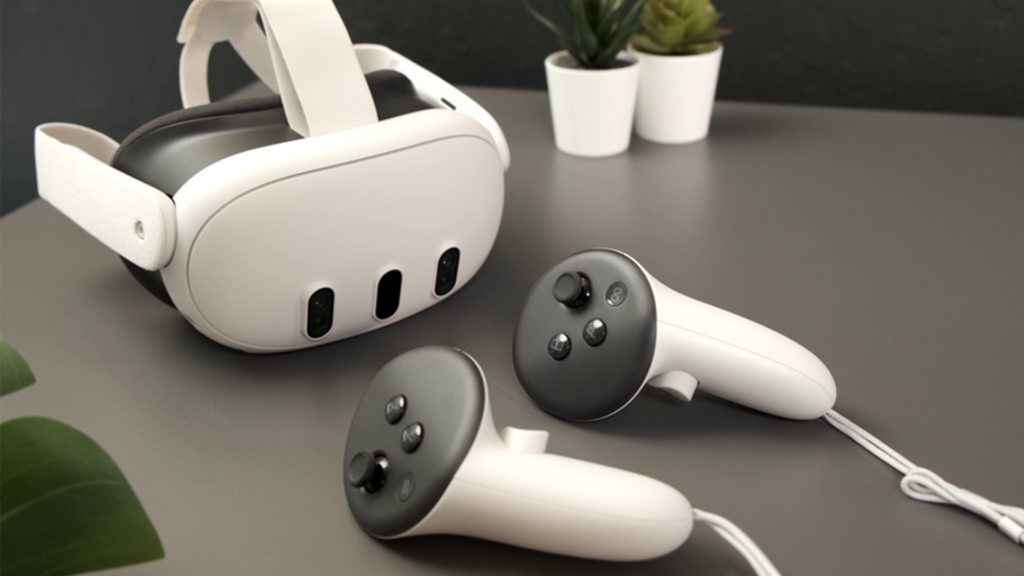
Pros
Cons
The Quest 3 is the next model after the Quest 2 and it’s better in every way. It’s more comfy to wear, has better screens, and has color mixed reality cameras. This means you can see the real world and virtual things at the same time. It costs more at $500, but it’s also a lot better than the Quest 2. It has the tech and visuals that will make you enjoy VR for a long time.
The Quest 3 uses Qualcomm’s Snapdragon XR2 Gen 2 chip. Meta says this chip has twice the graphics power of the Quest 2. You can see this extra power in games like Red Matter 2. These games have improved textures that make them feel more like PC VR. The Quest 3’s new displays have 2,064 by 2,208 pixels for each eye. This is even better than the PlayStation VR2. Its mixed reality cameras also let you see the real world easily. This is handy if you need to quickly reply to a text or Slack message. These cameras also let you play games that use your room.
The Quest 3 is interesting because it offers more than just good VR. It also shows you what a mixed reality future might look like. It’s not as clear or as good as Apple’s Vision Pro, but that’s okay. Like the older Quest models, you can also connect it to a gaming PC for better VR experiences.
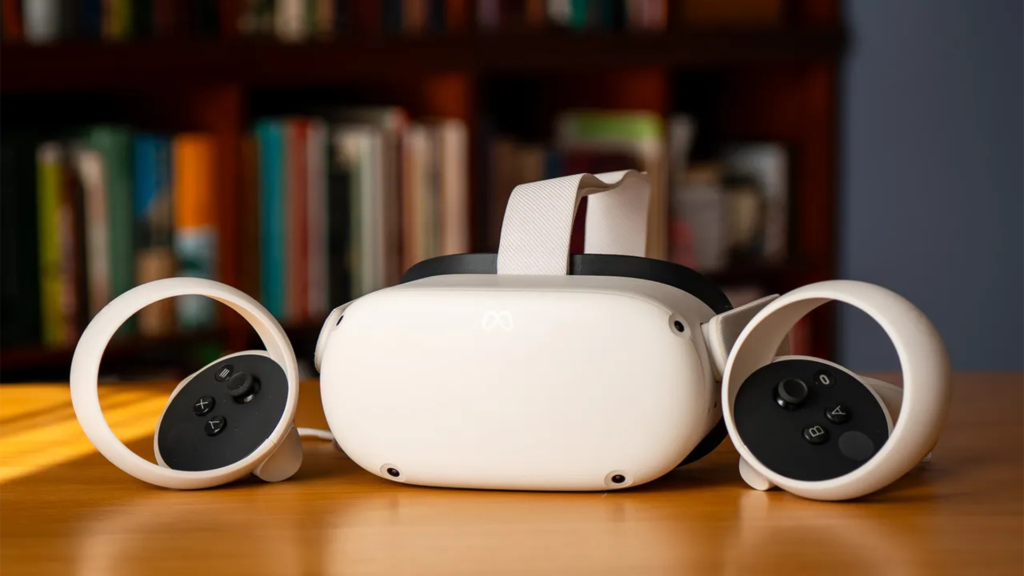
Pros
Cons
Right now, the Quest 2 is the cheapest and most flexible VR headset. You don’t need a gaming console or PC to use it, but you do need to connect it to a phone to set it up. The new Quest 3 seems better, but it costs more ($500), and we haven’t reviewed it yet.
Meta will keep supporting the Quest 2 with new software. But the Quest 3 has a better processor, so it’s more ready for the future. That’s why the Quest 3 seems worth the extra money. But if you want a cheaper option for families, the Quest 2 is still a great choice.
The basic model has 128GB of storage, which is enough for lots of games and apps. But remember, you can’t add more storage later. Meta now lets you use an account without logging in through Facebook, but you still need a new Meta account. Meta has also made the parental controls better for young players.
The Quest 2 is like the Nintendo Switch because it’s versatile and fun. It has a growing collection of fitness apps that work surprisingly well. You can also connect the Quest 2 to a PC to use more advanced apps from Steam or Meta’s own app library. You can do this with a single USB-C cable or wirelessly.
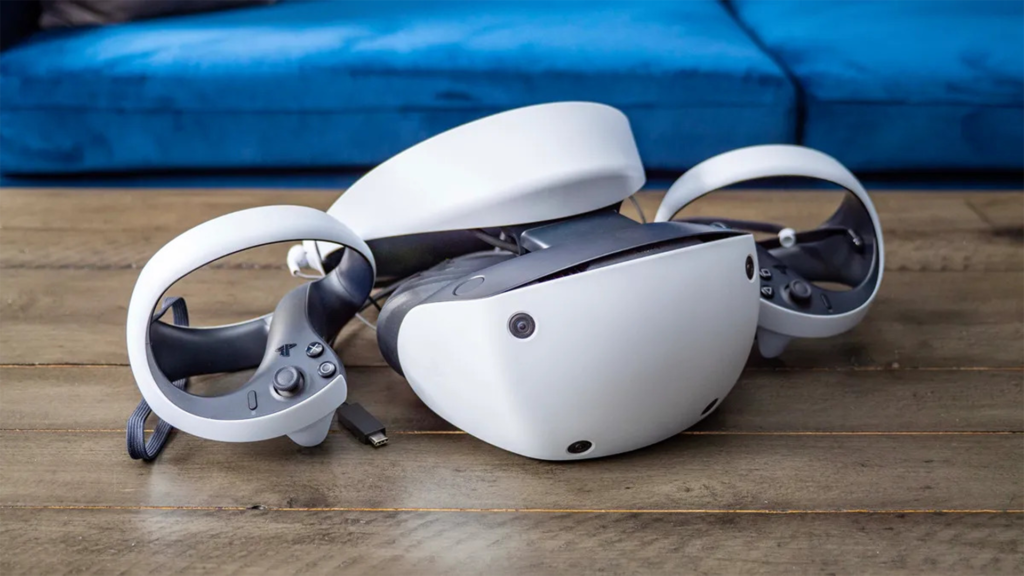
Pros
Cons
The PSVR 2 is quite costly, priced at $550, and it requires a PlayStation 5 to operate. It’s not wireless, but rather connected via a cable. Its HDR OLED display, the quality of its graphics, built-in eye tracking, and superb advanced controllers – which have the same vibrations and adaptive force-feedback triggers as the PS5 DualSense controllers – give this headset a high-end feel that allows its best games to perform at an extraordinary level. It could become a platform for top PC VR games, but currently, it already has some exclusive games like Gran Turismo 7, Resident Evil Village, and Horizon: Call of the Mountain.
The PSVR 2 doesn’t have any social metaverse-type software yet and feels more like a headset designed primarily for launching and playing VR games. Many of the games for this headset are versions of titles you could get on devices like the Quest 2. However, as more games that are optimized for this hardware are released, the PSVR 2 could quickly distinguish itself from other standalone VR devices. Unless you’re ready to take the plunge and trust Sony right away, you might want to wait and see how things develop.
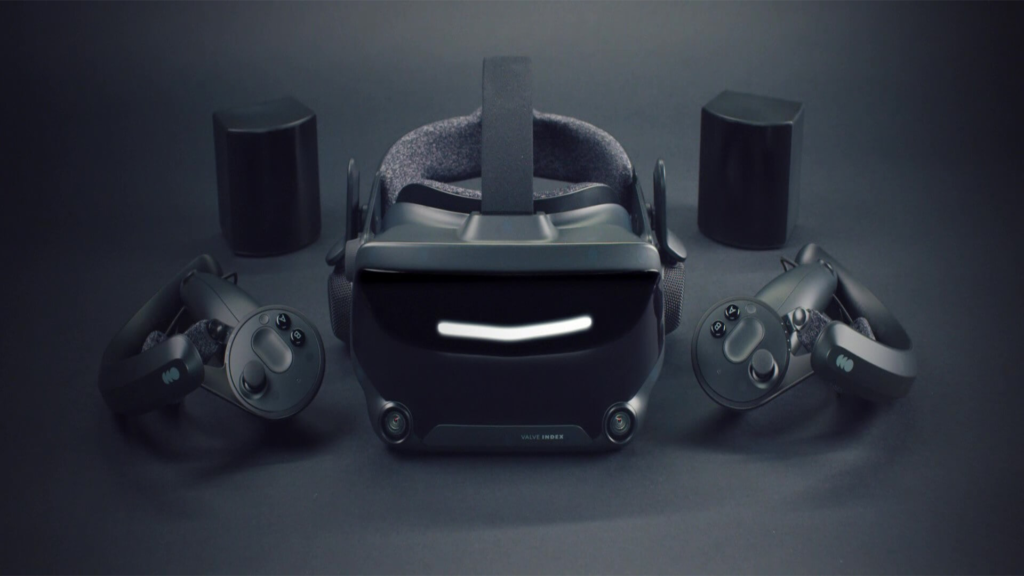
Pros
Cons
Valve’s Index kit is still one of the top high-end VR solutions available. For $999, you get the Index headset, Valve’s controllers that can track your fingers, and two SteamVR base stations. Even though we’ve seen headsets with higher resolution in the past two years, the Index is still a very solid choice. It has a resolution of 1,440 by 1,600 pixels, a refresh rate that can go up to 144Hz, and a wide field of view of 130 degrees. I’d happily give up a few pixels for the Index’s smoother and wider screen, which is still much better than most other consumer headsets.
As a product of SteamVR, the Index requires you to install two sensors in opposite corners of your room. And yes, it needs to be wired to your PC. But that bit of inconvenience is worth it for the higher refresh rate and more accurate tracking. Sure, it’s not as user-friendly as the Quest 2, but at this price range, we assume you’re willing to put up with a bit of hassle for a truly high-quality VR experience.
Valve’s controllers that can track your fingers are also great. They come with a handy strap that secures them to your hands. They make playing Half-Life: Alyx feel like a dream. It’s just too bad that other VR games haven’t fully utilized the finger tracking yet.
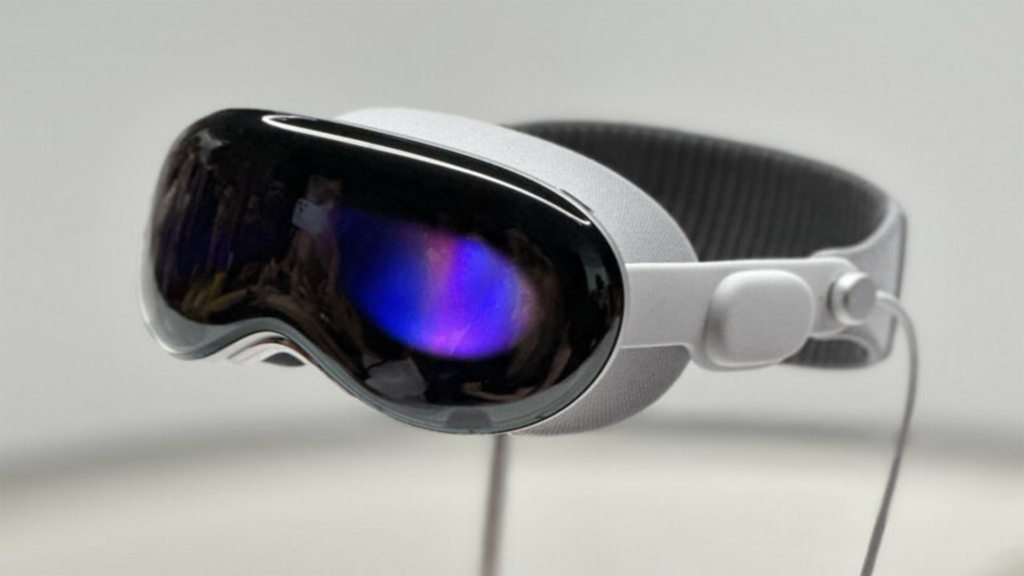
Pros
Cons
Apple is unique in the “standalone mixed reality computer headset” category because nothing else does exactly what the Vision Pro does. Most VR headsets so far have been game-focused and used for individual immersive creative and work apps to explore mixed reality ideas. The Vision Pro from Apple takes a different route by incorporating almost all of iOS. Having familiar Apple services and thousands of iOS apps in virtual workspaces feels like a future where our current devices and VR/AR merge.
The Vision Pro also has an amazing micro-OLED display that plays movies very well. The hand/eye tracking feels like the future and, at its best, it’s much more of a mouse/trackpad substitute than Meta’s hand tracking on Quest. Its mixed reality capabilities are the best we’ve ever seen, with passthrough cameras that are the highest quality of any standalone device.
The Vision Pro needs more apps to fully realize its potential and it doesn’t have many of the games and fitness experiences that Quest offers. As a work device, once some of the early software issues are fixed, it has incredible potential – it can also serve as a surprisingly good virtual monitor for Macs. As a luxury travel home theater for someone willing to spend $3,499, it’s also intriguing. At this price, regardless of how amazing the experience can be, it’s a product that most people should wait on or simply try a demo of first. Remember that the Vision Pro doesn’t work with glasses (you’ll need Zeiss prescription lens inserts, which cost an additional $100-$150), and the headset has its own tethered battery pack that must be used with the device, making it feel less self-contained than the Quest.
VR headsets have been common for about 10 years. The apps they use and the devices they connect to keep changing. We test important apps and software on the headsets. We use them on their own if they’re meant to be standalone, or with a PC, game console or phone if they’re meant to connect to something else. We use the headsets for different things like work, games, exercise and creative activities. We pay attention to any problems with the headsets (like discomfort, feeling disconnected or feeling sick or distorted). Using VR can be very personal, but by paying attention to details we can find out where each product is useful. Comparing is also important: I’ve looked at almost every AR and VR device you can wear in the last 15 years and also a lot of wearable tech, phones and computers. We think about how these devices work as game consoles, exercise devices, work tools and social tools. We also think about screens, sound, controllers and how they work with glasses.
Sometimes, it feels like Virtual Reality (VR) and Augmented Reality (AR) are not yet popular. But, changes are happening quickly in the world of headsets. Apple’s Vision Pro headset costs $3,499. It’s a VR/AR device that works on its own and Apple sees it as a full computer. It’s the most expensive device for customers. It’s different from devices like the Meta Quest that focus on games. The Vision Pro can run many iOS apps at the same time. This makes it special. It could be a good device for people who create things, do research, or anyone who can afford to pay for a top-quality personal cinema. It focuses on computing and video quality. This is different from the Quest, which is best for gaming and fitness.
The Vision Pro is not the only VR headset that combines virtual and real-world views. There are more like this, using color cameras to make it feel almost like you’re in augmented reality. The Quest 3 is the cheapest of these headsets, while Apple’s is the priciest. We expect to see more devices from Samsung and others soon.
The Snapdragon XR2 Gen 2 chipset from Qualcomm, which allows for this mixed reality, more AI features, and improved graphics, was first used in the Quest 3. It will be used in other headsets from 2024 onwards. A different version of this chip, the XR2 Gen 2 Plus, will be used in Samsung and Google’s more expensive headset.
Samsung, Google, and Qualcomm are working together on future products, which could include a mixed-reality headset as early as next year. If you’re interested in a device that connects to your phone, it might be best to wait and see what Samsung and Google come up with. Qualcomm’s plans for VR and AR involve using phones to power smaller glasses, but so far, there aren’t any small devices like this that we’d suggest.
Sony’s PlayStation VR 2, priced at $550, offers a solid VR gaming experience for PlayStation 5 owners. It includes eye tracking, similar to Apple’s Vision Pro, but it’s not wireless and is quite pricey (it costs more than the PS5 itself). It’s pricier than both the Quest 2 and Quest 3, and it still requires a PS5 to function. However, it’s much cheaper than a Vision Pro, even though it serves a different purpose and relies on a limited set of PlayStation VR games to function. Its limited library and functions make it less versatile than a Quest, but it’s a fun alternative for those deeply invested in Sony’s PlayStation 5 ecosystem.
For those who own a PC, there are several options. You could use a Quest 2, Quest 3 or Quest Pro, or consider a number of existing devices. The major players in the PC VR gaming scene (Microsoft, Valve, and HTC) have been quiet lately, especially since Microsoft has discontinued most of its mixed reality efforts. However, this could change soon. A VR headset connected to a PC can offer the most versatile collection of software for an immersive VR experience, and it also allows you to use the headset for creative and business tools.
The cost of a new VR headset is on the rise. If price is your main concern, the Quest 2 still offers the best value in VR: a completely wireless experience, with access to a great library of games.
A VR headset is like a high-quality screen close to your face. For wired headsets, a PC or game console does the work of creating a game. For wireless devices, like the Meta Quest 3, the headset does this work. They use either external sensors or built-in sensors to understand your physical space. They usually use controllers that track movement to make you feel like you’re in their 3D worlds.
We’re still waiting for a really good haptic VR bodysuit. But, you can still get accurate body tracking with most PC headsets that work with Steam VR. The Valve Index and HTC Vive Pro 2 both use sensors in the room that can understand your body better than the built-in sensors on other devices. You can add HTC Vive Trackers to wrist and leg straps, and belts, for even better tracking. The Meta Quest 3 doesn’t have easy body tracking solutions, but you can add Vive trackers when it’s connected to your PC to act like a Steam VR headset.
Only a few experiences, like VRChat, use full body tracking right now. There aren’t any body tracking solutions for the PlayStation VR and VR2 yet, but we’re interested in the company’s Mocopi body trackers, which were announced in Japan.
Oculus is the old name for Meta’s VR hardware. Right now, Meta only supports the Quest 3, Quest 2 and Quest Pro, which are all wireless headsets. As we said above, PC VR headsets can usually create better virtual reality, because they use more powerful graphics hardware.
Right now, Microsoft’s Xbox consoles don’t support any VR headsets.